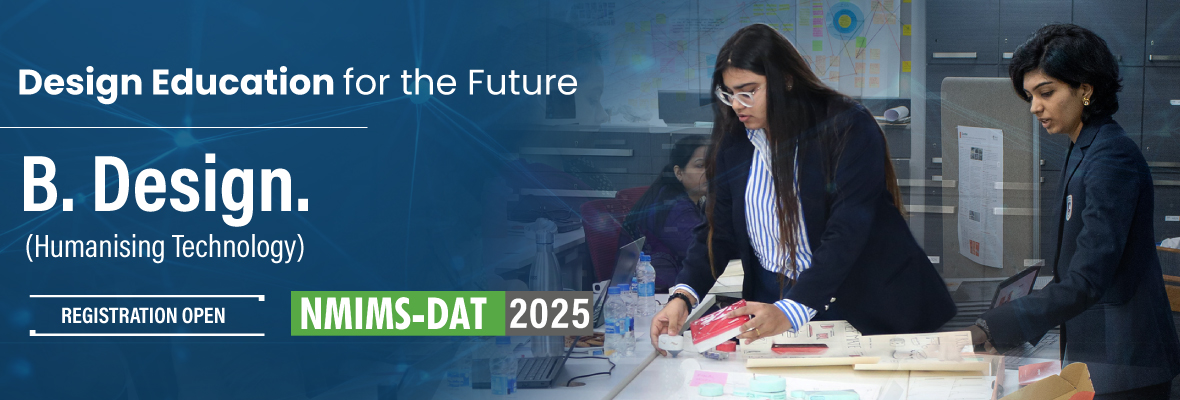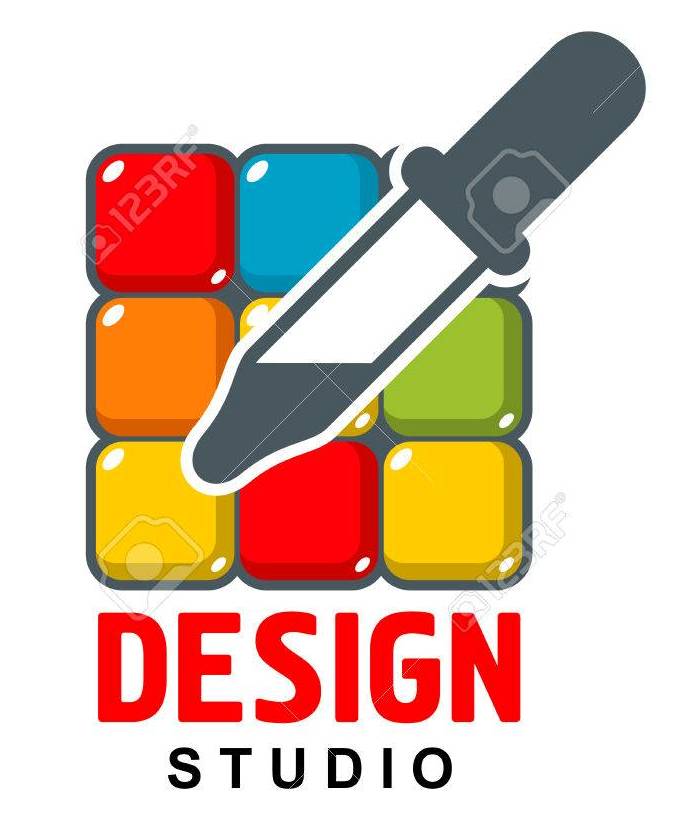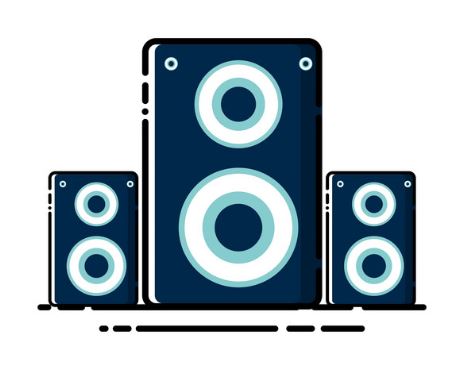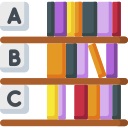
NMIMS Mumbai School of Design
The NMIMS School of Design in Mumbai is a premier institution offering cutting-edge design education, aimed at cultivating creative professionals who can adapt to the evolving demands of the industry. As part of NMIMS (Narsee Monjee Institute of Management Studies), the school integrates design thinking with technology, business, and user-centered approaches. Its curriculum emphasizes creativity, innovation, and problem-solving skills, preparing students for diverse careers in the design field. The flagship program, B.Des. in Humanising Technology, is a four-year undergraduate course that combines design, technology, and human-centered approaches, focusing on areas like UX/UI, interaction, and product design. The multidisciplinary curriculum balances theory, practical projects, and industry exposure, while experienced faculty, consisting of designers, academicians, and industry experts, guide students through both theoretical and hands-on learning. The school’s strong industry connections provide students with opportunities for internships, live projects, and workshops with leading companies and startups. With state-of-the-art studios, labs, and collaborative spaces, the NMIMS School of Design is committed to shaping well-rounded professionals who can lead in the rapidly changing world of design and innovation.
Courses
Highlights
- The NMIMS School of Design, a pioneering institute under NMIMS (Deemed to be University), Mumbai, has established a strong reputation with a record of providing 100% placement opportunities for its students.
- The school is ranked 4th best design school by career 360.
- Accredited by NAAC with a CGPA of 3.59 and an A+ grade, the school operates as an integrated campus approved by the All India Council for Technical Education (AICTE), New Delhi.
- The institute exclusively offers a B.Des. program focused on "Humanizing Technology."
- Admission is based on merit through the NMIMS Design Aptitude Test (DAT), ensuring that students with strong creative and design skills are selected.
|
Particulars |
Statistics |
|
Year of establishment |
2017 |
|
Recognised by |
UGC |
|
Modes of education |
Full-time |
|
Number of courses offered |
1 course |
|
Total no. of seats |
30+ |
|
Gender intake |
Co-ed |
|
Application mode |
Online |
NMIMS School of Design Mumbai Course
The NMIMS School of Design in Mumbai offers a specialized undergraduate program aimed at blending design with technology and user-centered innovation.
B.Des. in Humanising Technology:
- Duration: 4 years
- Overview: This unique program focuses on integrating design thinking with technology, creating solutions that enhance human experiences. Students are trained in areas such as UX/UI design, interaction design, product design, and innovation.
- Curriculum: The program covers a multidisciplinary curriculum that includes design fundamentals, user research, prototyping, digital tools, and design management, along with hands-on projects, internships, and industry exposure.
The B.Des. in Humanising Technology prepares students for a dynamic career in design by equipping them with the skills to solve real-world problems through creativity and technology.
NMIMS School of Design Mumbai Admission
The NMIMS School of Design in Mumbai follows a structured admission process for its B.Des. in Humanising Technology program, aimed at selecting candidates with strong creative and design potential.
Admission Process:
Entrance Exam:
- Admission is based on the NMIMS Design Aptitude Test (DAT), which assesses the candidate’s creativity, design thinking, and problem-solving skills.
- The exam evaluates drawing ability, observation, innovation, and visualization, essential for design.
Selection Process:
- After the NMIMS-DAT, shortlisted candidates are invited for a Personal Interview and Portfolio Review, where their design aptitude, creativity, and motivation for pursuing design are assessed.
Application:
- Candidates must apply online through the NMIMS website, fill in the necessary details, and submit the required documents and application fee.
- The selection process at NMIMS School of Design ensures that candidates with a passion for design, creativity, and innovation are chosen for the program.
NMIMS School of Design Mumbai Eligibility
The NMIMS School of Design in Mumbai has established specific eligibility criteria for its B.Des. in Humanising Technology program, ensuring that candidates with a strong foundation and passion for design are selected. Open to students from diverse educational backgrounds, including Science, Commerce, and Arts, the eligibility requirements aim to attract creative thinkers who are eager to explore the intersection of design, technology, and user-centered innovation. By setting clear academic and entrance exam standards, the school ensures that only the most motivated and talented students are admitted.
|
Courses |
Duration |
Eligibility |
|
B.Des |
4 Years |
12th passed or equivalent with minimum 50% marks in any stream. |
NMIMS School of Design Mumbai Fees
The NMIMS School of Design in Mumbai offers a specialized B.Des. in Humanising Technology program with a fee structure that reflects the quality of education, state-of-the-art facilities, and industry exposure provided to students. While the fees may vary slightly each year, they are designed to ensure that students receive access to top-notch resources, experienced faculty, and hands-on learning experiences. Additionally, NMIMS provides financial aid options and scholarships for deserving students, helping to make quality design education more accessible.
|
Courses |
Duration |
Annual Fees |
|
B.Des |
4 Years |
5,00,000 /- |
NMIMS School of Design Mumbai Cutoffs
The NMIMS School of Design in Mumbai sets competitive cutoff criteria for its B.Des. in Humanising Technology program, ensuring that only the most talented and creative students are admitted. The cutoffs are primarily based on the NMIMS Design Aptitude Test (DAT), which assesses candidates' design thinking, creativity, and problem-solving skills. Meeting the cutoff is crucial for progressing to the next stages of the admission process, which includes a personal interview and portfolio review. These cutoffs help the school maintain a high standard of student quality and ensure that those selected are well-suited for the challenging and innovative design curriculum.
NMIMS School of Design Mumbai Placement
The NMIMS School of Design in Mumbai is a prime destination for leading companies from various industries that actively participate in on-campus recruitment drives. The institute's Placement Cell, known as the Corporate Resource Centre, plays a vital role in linking students with career opportunities. It provides mentorship, training, and guidance, ensuring students receive comprehensive support throughout the recruitment process.
|
Highest Package |
13,34,468 LPA |
|
Average Package |
7,50,247 LPA |
|
Placement Rate |
100% |
|
Top Recruiters |
Deloitte, PwC, HFI, Parallax, etc. |
NMIMS School of Design Mumbai Recruiters
The NMIMS School of Design in Mumbai has built strong relationships with top recruiters across various industries, making it a preferred choice for companies seeking talented design professionals. The school’s focus on innovation, creativity, and practical experience prepares students for diverse roles in sectors such as UX/UI design, product design, and digital innovation. Through the efforts of its dedicated Corporate Resource Centre, students are connected with leading organizations for internships and full-time placements, ensuring they have ample opportunities to launch successful careers in the design industry.
Internship
|
Highest Stipend |
50,000/- |
|
Average Stipend |
17,900/- |
|
Internship |
100% |
NMIMS School of Design Mumbai Review
|
Placements |
4.5 |
|
Infrastructure |
4.2 |
|
Faculty & Course Curriculum |
4.5 |
|
Crowd & Campus Life |
4.1 |
|
Value of Money |
4.3 |
NMIMS School of Design Mumbai Ranking
The NMIMS School of Design in Mumbai is steadily gaining recognition in the field of design education due to its unique curriculum and focus on integrating design with technology. While the school is still building its legacy, its parent institution, NMIMS, holds a prestigious position in the academic world, which positively influences its reputation. The NMIMS School of Design has been acknowledged for its innovative programs, experienced faculty, and strong industry connections, contributing to its rising rank among design schools in India.
Faculty (10)
';|
S.No |
Faculty |
|
1. |
Dr. Guruprasad Kuppu Rao |
|
2. |
Dr. Arundhati Guha Thakurta |
|
3. |
Geet Sharma |
|
4. |
Himabindu P |
|
5. |
Nitin Shantaram Nigde |
|
6. |
Pranav Prabhakar More |
|
7. |
Shirsekar Siddhesh Sushil Sheetal |
|
8. |
Sneh Hazra |
|
9. |
Sudhakar Yashwant Kalgutkar |
|
10. |
Sudhir Bania |
Facilities

Wi-Fi Campus

Sports Complex

Banks Facilities

Design Studio

Gym

Hostel

AC Classrooms

Auditorium

Cafeteria

Convenience Store

Dance Room

Labs

Medical Facilities
_facility.png)
Moot Court (Law)

Music Room

Ransomware by ./M789

Shuttle Service
Contact
Building, Nmims School of Design 6th floor UPG College, Bhaktivedanta Swami Rd, JVPD Scheme, Vile Parle West, Mumbai, Maharashtra 400056
sod@nmims.edu
-
PGDM-Post Graduate Diploma in Management
Total Fee: INR 745000
-
B.Com Bachelor of Commerce
Total Fee: INR 240000
-
PGDM-Post Graduate Diploma in Management
Total Fee: INR 745000
-
B.Com Bachelor of Commerce
Total Fee: INR 240000
-
PGDM-Post Graduate Diploma in Management
Total Fee: INR 745000
-
B.Com Bachelor of Commerce
Total Fee: INR 240000
-
PGDM-Post Graduate Diploma in Management
Total Fee: INR 745000
-
B.Com Bachelor of Commerce
Total Fee: INR 240000
Highlights
- International Institute of Business Studies (IIBS) is an AICTE Approved college which is recognized by Ministry of HRD, Government of Indias
- IIBS rated India’s No.1 emerging B-School in placement by Samaja Parivarthana
- Faculty of IIBS consists of experienced corporate faculty with 65% Ph.D. holders
- Ranked 2nd among 'Top 10 Southern B Schools' by Silicon India, 2017
- Ranked 3rd in Placement among the Best B-School in India 2017 by Silicon India
Modern Facilities
- Smart Classroom: IIBS provides fully equipped classroom with air-conditioned, projectors, remote controlled LCD and high speed connected computers and cordless microphones
- Library: It is fully equipped by highly information recourses like latest periodicals, reference texts, management text books, national and international journals and DVDs and well organized
- Digital Library: Students of IIBS can be access the digital library through any computers by using their ID and password
- Auditorium: IIBS auditorium is fully furnished and laced with all modern devices to more impactful view
- Hostel: IIBS provides hostel accommodation for boys and girls with mesh facility
Conducting IIMs have been changed the pattern of the CAT exams several times over the years. It is extremely beneficial for the aspirants to know the CAT paper pattern as it helps in preparation and the aspirants can prepare according to the pattern and weightage of the topics.
Overview of the Exam Pattern of CAT 2020
| Mode of the Exam | Online Only |
|---|---|
| Total number of Questions | 100 |
| Total Marks | 300 |
| Duration of the Examination | 3 hours (180 minutes) |
| Sectional Division of the Paper | 3 sections |
| Types of the Questions | Both MCQs and Non MCQs |
| Marking Scheme |
For Correct Answers → +3 marks For Incorrect Answers → -1 mark For Unattempted Questions → No marks |
| Name of the Sections |
1. Verbal Ability & Reading Comprehension 2. Logical Reasoning & Data Interpretation 3. Quantitative Aptitude |
This Exam is conducted once in a year usually in the month of November on online mode and it is expected that this year this exam will held in the last week of November. The question paper contains 100 questions to be solved in 3 hours. 3 marks are assigned for correct answer and 1 mark is deducted for wrong answer in CAT Exam. English is the only medium of answering the questions. Each question consists of four choices from which only one is correct, candidates have to select the right answer from the given options.
CAT question paper consists of three sections divided as
- 1. Verbal and Reading Comprehension (VARC)
- 2. Data Interpretation & Logical Reasoning (DI & LR)
- 3. Quantitative Ability (QA)
Overview of the Exam Pattern of CAT 2020
| Section’s Name | Number of Questions | Duration (in mins) |
|---|---|---|
| Verbal and Reading Comprehension (VARC) | 34 | 60 |
| Data Interpretation & Logical Reasoning (DI & LR) |
VA → 10 Questions RC → 24 Questions |
60 |
| Quantitative Ability (QA) |
DI → 16 Questions LR → 16 Questions |
60 |
| Total | 100 | 180 minutes (3hours) |
Verbal Ability and Reading Comprehension Section
This section is a combination of two sub-sections namely Verbal Ability (VA) and Reading Comprehension (RC). The main focus of this section is on the English language skills of the candidates and how they understand and elucidate the paragraphs and Passages. This section consists of 34 questions, 10 questions of Verbal Ability and 24 questions of Reading Comprehension. Verbal ability sub-section consists of questions related to Para-jumbles, Summary based questions, Sentence Correction and Completion. The other sub-section, Reading Comprehension is based on the questions related to Vocabulary, title etc.
Logical Reasoning & Data Interpretation Section
This section is also divided into two sub-sections, one is Logical Reasoning (LR) and other is Data Interpretation (DI). A total of 32 questions are asked in this section, 16 questions from both the sub-section. LR section contains solvable questions generally from the topics like inequalities, symbol operations, direction sense test etc. On the other hand DI section is a little difficult and time-consuming section as it consists of several confusing data case lets questions. This section contains tricky question and a little mistake in understanding the case lets can lead the candidates to attempt all the questions from a particular set incorrectly.
Quantitative Aptitude Section
This section is a standalone section which comprises only numerical questions from different topics of Math. A total of 34 questions are asked in this section. This section contains questions based on Basic Arithmetic, Number System, Geometry, Algebra, Modern Math etc. The questions in this section ranges from easy to moderately high and can be answered easily with proper practice of the syllabus of Quantitative Aptitude.

|
Prof. Prabhakar H
B.Sc., PG in HRD, PG in Training & Development |

|
Prof. Prabhakar H
B.Sc., PG in HRD, PG in Training & Development |

|
Prof. Prabhakar H
B.Sc., PG in HRD, PG in Training & Development |

|
Prof. Prabhakar H
B.Sc., PG in HRD, PG in Training & Development |

|
Prof. Prabhakar H
B.Sc., PG in HRD, PG in Training & Development |

|
Prof. Prabhakar H
B.Sc., PG in HRD, PG in Training & Development |
Facilities













CAT 2020 will be conducted in the following cities:
| Port Blair | Kurnool | Nellore | Tirupati |
| Vijaywada | Visakhapatnam | Chittoor | Itanagar |
| Dibrugarh | Guwahati | Silchara | Aurangabad |
| Gaya | Muzaffarpur | Patna | Chandigarh |
| lorem | lorem | lorem | lorem |
Contact Us
#75, Muthugadahalli, Bangalore North Jala Hobli, near International Airport airport(New Airport), Bangalore ( Karnataka)
admission@iibsonline.com









